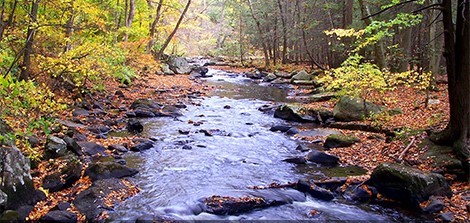September 8, 2020
DEP : It’s 2004, Saving the Environmentally Sensitive Highlands Region
The New Jersey Highlands Region has forests, wetlands, streams and reservoirs. It provides habitats for black bears, butterflies, bog turtles and wild trout, as well as many other species of wildlife and more than 100 plants.
 The Highlands boast hiking trails, swimming holes, ski trails and bird-watching spots. The region offers opportunities for golfing, windsurfing, sailing, fishing, geo-caching and biking.
The Highlands boast hiking trails, swimming holes, ski trails and bird-watching spots. The region offers opportunities for golfing, windsurfing, sailing, fishing, geo-caching and biking.
The area is home to farms and orchards ripe with fruits and vegetables (from berries and peaches to tomatoes and eggplants), as well as vineyards cultivating cabernets, chardonnays, Rieslings, roses and several New Jersey original varieties.
The Highlands Region also supplies water to more than 300 municipalities and more than two-thirds of New Jersey’s residents, according to the New Jersey Highlands Council.
Its preservation and protection are paramount, so much so that 16 years ago New Jersey mandated its safeguarding by law.
That commitment remains as strong today: “In 2019, the Highlands Council continued to support municipalities and counties in numerous efforts to protect the natural resources and strengthen the diverse economies of the Highlands Region. Some highlights include our work advancing lake management, stormwater management and watershed management planning projects. … (and worked) to protect hundreds of acres via deed restrictions or outright land purchases. Land preservation continues to be a vital component of implementing the Highlands Act and the Regional Master Plan,” the Council noted in its 2019 annual report.
And now, a look at 2004 …
On Aug. 10, 2004, then-Gov. James McGreevey signed the Highlands Water Protection and Planning Act, preserving nearly 400,000 acres of environmentally sensitive land in New Jersey’s Highlands – a mountainous region that stretches across seven counties in the northwestern part of the state and is the source of clean drinking water for more than 70 percent of New Jersey residents.
“The Highlands Region has long been one of the missing jewels in this country’s – and our state’s – preservation efforts. No longer,” said McGreevey, during a signing ceremony at the Wanaque Reservoir Dam, where he was joined by two former governors and a host of local officials.
Part of the Appalachian Mountain chain, the Highlands Region in New Jersey encompasses 859,358 acres and is known for its scenic beauty, rich history, and diverse geographic and geologic features, including steep ridges, dense forests, bucolic valleys and wetlands. The region also provides critical habitat for many rare and endangered wildlife, such as bears, bobcats, native trout and interior bird species.
Between 1995 and 2000, suburban sprawl consumed 25,000 acres of forests and farmland in the Highlands and population growth increased in the region nearly 50 percent faster than the statewide rate, sparking increasing urgency to preserve the area.
The Highlands Act divided the region roughly in half – a preservation area and a planning area – and established the Highlands Water Protection and Planning Council, which was charged with creating a regional master plan to protect and enhance the area’s natural resources.
###
 OFFICIAL SITE OF THE STATE OF NEW JERSEY
OFFICIAL SITE OF THE STATE OF NEW JERSEY